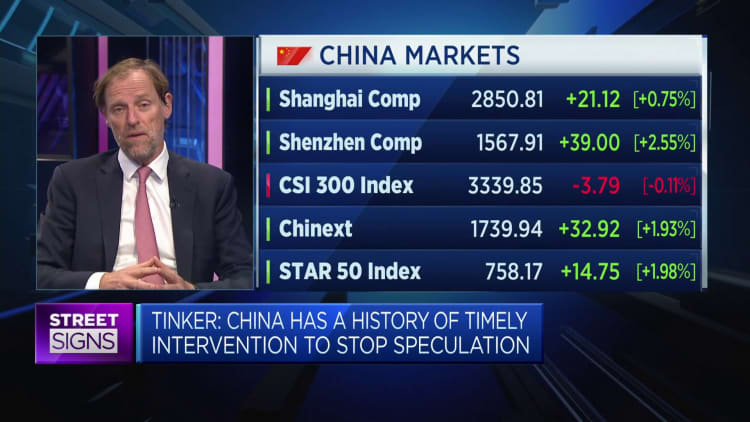The
portrait
of
Mahatma
Gandhi
is
displayed
on
Indian
rupee
banknotes
in
an
arranged
photograph
in
Bangkok,
Thailand,
on
Wednesday,
Sept.
12,
2018.
Brent
Lewin
|
Bloomberg
|
Getty
Images
The
U.S.
Federal
Reserve
is
expected
to
cut
interest
rates
later
this
year
and,
while
that
may
not
be
good
news
for
the
dollar,
some
Asian
currencies
stand
to
benefit.
Higher
interest
rates
boost
a
country’s
currency,
attracting foreign
investment
and
increasing
demand
for
the
country’s
currency.
A
weak
U.S.
dollar
is
generally
positive
for
emerging
markets,
which
is
often
the
case
when
the
Fed
cuts
interest
rates
outside
of
an
economic
crisis.
The
Fed
shifted
to
a
more
dovish
stance
in
December,
with
markets
now
pricing
in
rate
cuts
by
summer.
The CME
FedWatch
tool suggested
the
first
25-basis-point
rate
cut
in
2024
could
happen
as
early
as
June.
The Fed’s
January
meeting
concluded
with
the
central
bank
holding
its
benchmark
borrowing
rate
in
a
range
between
5.25%
and
5.5%.
Experts
told
CNBC
currencies
such
as
the
Chinese
yuan,
the
Korean
won
and
the
Indian
rupee
stand
to
benefit
from
the
Fed
loosening
monetary
policy.
Yuan
can’t
go
any
lower
China
has
weathered
a
slew
of
disappointing
headlines
that
have
beaten
down
investor
confidence.
But
hopes
that
authorities
would
not
allow
the
trade-reliant
nation’s
currency
to
weaken
below
a
certain
level
have
limited
yuan
pessimism.

watch
now
China
has
tried
to
stabilize
the
yuan
against
the
dollar
in
the
past
and
is
expected
to
continue
doing
so,
according
to
Arun
Bharath,
chief
investment
officer
at
Bel
Air
Investment
Advisors.
“While the exchange
rate
has
weakened
to
a
7
handle
on
the
USD/CNY
rate, reflecting a weaker
economic
situation
in
China,
further
weakening
is
unlikely
as
policymakers start
to
be
more
aggressive
in
fiscal
stimulus,
credit
growth, and
propping
up
property
values,”
Bharath
said.
He
noted
that
the
Chinese
currency’s
exchange
rate
will
likely
hover
in
“a
narrow
band
around
the
current
exchange
rate
of
7.10.”
Unlike
other
major
currencies
like
the
Japanese
yen
or
U.S.
dollar
which
have
free
floating
exchange
rates,
China
keeps
strict
control
of
the
onshore
yuan.
The
currency
is
pegged
with
a
so-called
daily
midpoint
fix
to
the
greenback
based
on
the
yuan’s
previous
closing
level
and
quotations
taken
from
inter-bank
dealers.
Last
year,
the
onshore
yuan
hit
a
16-year
low
against
the
dollar
at
7.2981.
If
the
Fed
starts
cutting
rates
by
summer,
that
would
likely
narrow
the
yield
differentials
between
the
world’s
two
largest
economies
and
alleviate
some
pressure
off
the
Chinese
yuan.
Yield
differentials
is
a
way
to
compare
bonds
through
the
differences
between
how
much
they
yield.
The
People’s
Bank
of
China
is
a
main
player
in
managing
the
currency,
which
Simon Harvey,
head of FX analysis
at
Monex,
said
can
be
done
through
its
daily
fixing,
liquidity
measures,
regulatory
channels,
and
instructing
state
banks
to
intervene.
That
last
method
is
the
most
opaque
as
the
total
value
of
dollars
in
China’s
FX
reserves
is
unknown.
Rupee
riding
high
The
Indian
rupee
could
benefit
from
carry
trades
this
year,
a
strategy
where
traders
borrow
low-yielding
currencies
such
as
the
U.S.
dollar
in
order
to
buy
high-yielding
assets
like
bonds.
“A
lot
of
carry
trade
against
other
currencies
like
the
yen
or
the
euro
but
once
interest
rates
fall
in
the
U.S.,
we
will
see
the
interest
rate
differential
widen
to
allow
carry
trade
to
happen.
So
those
are
also
positive
for
the
Indian
currency,”
said
Anindya
Banerjee,
vice
president
of
currency
and
derivatives
research
at
Kotak
Securities.
The
rupee
could
also
strengthen
amid
hopes
the
Reserve
Bank
of
India
may
loosen
monetary
policy
more
slowly
than
other
central
banks.
Banerjee
noted
that
the
RBI’s
rate
cut
pace
will
be
“far
slower”
than
the
Fed
and
“will
always
significantly
lag
the
Fed
because
India
did
not
have
the
same
inflation
problem
which
Europe
or
America
had.”
“The
reason
is
simple,
because
fiscal
policy
is
firing
on
all
cylinders,
the
economy’s
doing
very
well
and
they
don’t
want
any
overheating
at
this
point
in
time,”
Banerjee
said.
The
rupee
has
strengthened
to
as
much
as
82.82
against
the
dollar
in
the
last
three
months.
The
currency
dipped
0.6%
in
2023,
a
much
smaller
weakening
against
the
dollar
compared
to
the
prior
year’s
11%
decline.
Pressure
off
Korea’s
won
South
Korea’s
won
has
been
under
pressure
for
three
years,
but
improving
economic
prospects
and
looser
Fed
policy
will
help
ease
that
strain
in
2024.
“As
a
low
yielding
and
highly
cyclical
currency,
we
think
the
Korean
won
stands
to
be
one
of
the
major
beneficiaries
of
the
Fed’s
easing
cycle
in
the
second
half
of
the
year
as
lower
U.S.
rates
will
not
only
reduce
pressure
on
KRW
through
the
rates
channel
but
will
also
lead
to
an
uptick
in
the
global
growth
outlook,”
Monex’s
Harvey
said.

watch
now
But
Harvey
said
the
won’s
gains
will
also
be
determined
by
the
extent
of
the
Fed’s
cuts.
He
predicted
the
currency
could
gain
anywhere
between
5%
and
10%
if
the
easing
cycle
is
deep,
while
as
little
as
3%
if
the
cycle
proves
to
be
shallow.
South
Korea’s
economic
prospects
are
also
expected
to
improve
this
year.
The
International
Monetary
Fund
predicted
2.3%
growth
in
2024
and
2025,
higher
than
last
year’s
growth
of
1.4%.
